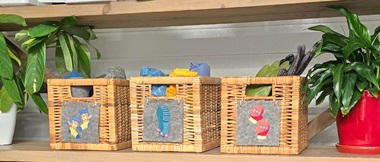
Wow – embroidery can be fuzzy!
Add the wow factor to your project with three-dimensional, textured embroidery!
Yarn couching is a very exciting embroidery feature available on the Brother Stellaire and Luminaire models*.
In this How to Anni from Handmadebyanni shows us how it’s done.

Yarn couching embroidery is a built-in feature on the following Brother models:
*For Stellaire XJ1/XE1 and Luminaire XP1 users, you can buy the relevant upgrade kits which will contain this feature and the couching tools.
Materials needed
- Yarn – see our tip (below) on which yarn is suitable
- Embroidery thread in matching colour
- Textile to be embroidered
- Appropriate stabiliser for fabric used
Yarn suitable for yarn couching:
Worsted weight yarn is recommended for machine embroidery yarn couching on Brother embroidery machines. Check the ball band that comes with your yarn. The knitting tension should be approximately 20 stitches per 10cm or 9 – 11 wraps per inch. It is a good idea to test the result of the yarn you plan to use on the same or similar fabric to your project first.
Equipment needed
- Yarn couching embroidery equipment - these came with your machine or your upgrade kit: couching foot, yarn guide and threading needle
- Snips or scissors
- Spray adhesive
- Iron
- Water-soluble marker
We used a magnetic frame – if you haven’t tried them, you should!

How to
Step 1
Attach the couching foot and the thread guide to the embroidery machine.

Step 2
The yarn for the embroidery must be rolled up loosely and then placed on the telescopic thread guide or just loosely on the machine.

Step 3
The needle must be adjusted slightly to the left to make room for the wool. To do this, turn the wheel on the couching foot. Test the penetration point of the needle by turning the handwheel.
Tip: if the needle is not sitting in the left half of the presser foot hole, adjust the foot position by turning the screw on the right hand side of the yarn couching presser foot towards the back to move the foot to the right, and so the needle will be positioned to the left. Test the position of the needle penetration again by turning the hand wheel. The needle must not touch the foot!

Step 4
Thread the yarn through the yarn guide and guide it through the hole in the couching foot using the threading needle.
CAUTION: Do not thread your yarn through the eye of the needle. Only the colour-matching thread should pass through the needle. Also make sure that the yarn can continuously unroll loosely as you embroider. It is best to keep an eye on the yarn during the entire embroidery process.

Step 5
Prepare the fabric. Fold your fabric in half once and iron the centre front.
Then use the marker to mark the height and position of the embroidery.

Step 6
Adhere your stabiliser to the fabric and hoop them into the appropriately sized frame. If you are using one of the fabulous new magnetic hoops, remove all the magnets and place the stabilised fabric in the centre. Fix it in place with the magnets. Load the hoop into the embroidery machine. Check that the protruding fabric is not caught under the frame.

Step 7
On your embroidery machine’s screen, tap on ‘Embroider’ and then on the C with the letter and rose symbols. You can now select either a couching motif or one (or more) letters and prepare them for embroidery. If several letters are to be combined to form a word, go to: Set - Edit - Add and repeat this step until the word is complete.

Step 8
Move the embroidery to the desired position.
Step 9
Start embroidering. Hold the thread and wool ends forwards, towards you, briefly at the beginning. If your design contains several letters or motifs, as in the example, stop the machine after each motif. Pull approximately 30cm of the thread and yarn through the needle and the hole of the foot. Cut both approximately 15cm from the needle, so you are left with a piece long enough to hold onto for the next letter, and also a long enough piece to thread to the back on the already embroidered letter.

Step 10
Once the couching embroidery is complete, remove the hoop from the machine, remove the fabric from the hoop and separate the fabric from the stabiliser if needed.

Step 11
Use the threading needle and an awl if needed to pull the threads from the front to the back of your fabric. Secure them with a knot or sew the ends into the back of the stitches with a darning needle.
On a garment, you can add a piece of fusible interfacing to cover the back of the stitching. This not only protects the back of the embroidery and the threads, but also the wearer's skin.

Step 12
Finish sewing your project. DONE!




